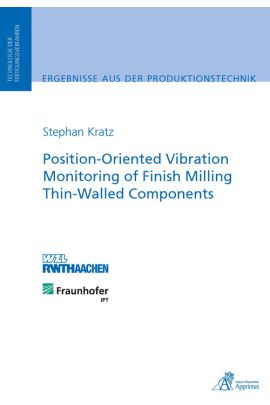Focus of the thesis, 'Position-oriented Vibration Monitoring of Finish Milling Thin-walled Components' is the development of a monitoring system for finish milling thin, free-standing components. In particular this system is of great interest for the production of impellers and blisks used in compressor and turbine stages.
Because of the component’s varying dynamic behavior and the associated change in process stability, the core steps of development presented for such a monitoring system are:
- the reliable and trouble-tolerant identification of the current process state by means of appropriate measuring signals,
- the development of analytical strategies for the process diagnosis and
- the implementation and verification of algorithms, which allow an online evaluation of the product’s quality, during the finish milling operation. Based on the identified process disturbances that occur during the finish milling of thin-walled components, the essential requirements for such a monitoring system are defined. As an analogy to machining blades, the finishing of thin-walled cantilevers, which are stepwise varied in their length, is examined.
To measure the dynamic process behavior a non-contact eddy current sensor and two piezoelectric acceleration sensors are identified as suitable sensor solutions. While the eddy current sensor is positioned towards the tool, one acceleration sensor is mounted on the machine table and the other at the machine spindle’s housing. A key result of the signal analysis is the finding that a position-oriented evaluation of the sensor signals is needed to perform a distinct evaluation of the process behavior. To illustrate this requirement, a new analysis method called frequency map analysis is developed and introduced for the first time. The frequency map analysis shows that amplitudes of certain frequencies are assignable to resulting dimensional deviations and the surface roughness of the thin-walled component.
Based on these findings monitoring algorithms are specified, implemented and verified, which allow a segmented evaluation of the component’s finishing quality. The developed monitoring strategy performs an automated signal evaluation and an implemented assessment of the process’s status using three levels of quality evaluation: acceptable, borderline and unacceptable. The monitoring system is verified, machining cantilever beams and finish milling an impeller. The thesis concludes with an outlook presenting a concept for position-oriented, model-based control of a finish milling operation.
| Autor | Kratz, Stephan |
|---|---|
| Lieferzeit | 3-4 Tage |
| Gewicht | 0.2 kg |
| Erscheinungsdatum | 20.05.2011 |
Technologie der Fertigungsverfahren
Position-Oriented Vibration Monitoring of Finish Milling Thin-Walled Components
Kurzbeschreibung
Focus of the thesis, 'Position-oriented Vibration Monitoring of Finish Milling Thin-walled Components' is the development of a monitoring system for finish milling thin, free-standing components. In particular this system is of great interest for the production of impellers and blisks used in compressor and turbine stages.
Because of the component’s varying dynamic behavior and the associated change in process stability, the core steps of development presented for such a monitoring system are:
- the reliable and trouble-tolerant identification of the current process state by means of appropriate measuring signals,
- the development of analytical strategies for the process diagnosis and
- the implementation and verification of algorithms, which allow an online evaluation of the product’s quality, during the finish milling operation. [...]

